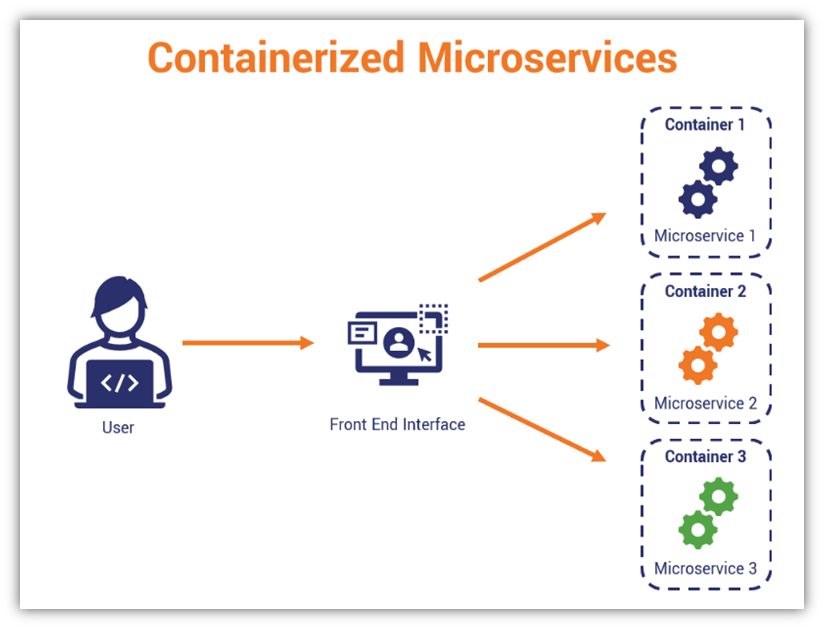Introduction: Containerization and microservices have emerged as transformational technologies in the ever-changing world of software development. They have transformed application design, development, and deployment, ushering in a new era of scalability, flexibility, and efficiency. This essay goes into the core ideas of containerization and microservices, as well as future trends that have the potential to impact the software development industry.
Understanding Containerization and Microservices
Containerization: A Modular Approach
Containerization involves packaging an application and all its dependencies into a single, lightweight unit known as a container. These containers, often based on technologies like Docker, provide a consistent and isolated environment for an application to run. This ensures that applications run consistently across different environments, from development to production.
One of the key benefits of containerization is the ability to scale horizontally effortlessly. It allows applications to be deployed quickly and consistently on any platform that supports containers. This simplicity, combined with the isolation containers provide, has made them an integral part of modern software development.
Microservices: Breaking Down Monoliths
Microservices, on the other hand, is an architectural approach where applications are broken down into smaller, independent services that interact with each other through well-defined APIs. Unlike monolithic applications, where changes in one part may affect the entire system, microservices allow developers to make changes, updates, and enhancements to specific services without disrupting the entire application.
The benefits of microservices are numerous, including improved scalability, fault isolation, and development agility. Microservices enable organizations to react quickly to changing business requirements and ensure that applications remain robust and efficient.
Future Trends in Containerization and Microservices
Serverless Computing and Microservices Integration
Serverless computing is on the rise, and its integration with microservices is set to be a significant trend. Serverless platforms, such as AWS Lambda and Azure Functions, allow developers to focus solely on writing code without the need to manage servers. Integrating serverless functions with microservices can provide a powerful, cost-effective solution for specific tasks within a microservices architecture.
AI and Machine Learning in Containers
The use of artificial intelligence and machine learning within containers is becoming increasingly prevalent. Data scientists and developers are leveraging containers to package machine learning models and their dependencies, making it easier to deploy these models at scale. This trend is expected to drive innovation in various domains, including healthcare, finance, and autonomous systems.
Kubernetes Dominance
Kubernetes, an open-source container orchestration platform, is set to maintain its dominance in the containerization and microservices landscape. It simplifies the management of containers, ensuring high availability, scaling, and efficient resource utilization. As more organizations adopt Kubernetes, it will continue to shape the future of containerized applications.
Security and Compliance Focus
As the use of containers and microservices becomes more widespread, so does the need for enhanced security and compliance measures. Future trends will see a heightened focus on container security, with advancements in tools and practices to protect against vulnerabilities and unauthorized access. Additionally, regulatory compliance in various industries will influence the design and deployment of containerized applications.
Conclusion
Containerization and microservices are transforming the way we develop and deploy software applications. Their flexibility, scalability, and efficiency have already made them invaluable in the software industry. Looking ahead, the integration of serverless computing, AI, and machine learning, the continued dominance of Kubernetes, and a heightened focus on security and compliance are the future trends that will shape the landscape of containerization and microservices. As organizations adapt to these trends, they will be better positioned to build robust, responsive, and innovative software applications.
What is containerization, and how does it differ from virtualization?
Containerization involves packaging an application and its dependencies into a single, lightweight container, while virtualization uses hypervisors to create isolated virtual machines. The key difference lies in resource utilization and isolation. Containers are more lightweight and share the host OS, making them more efficient than virtual machines.
How do microservices improve software development compared to monolithic architectures?
Microservices break down complex applications into smaller, independently deployable services. This approach improves scalability, fault isolation, and development agility. Developers can make changes to specific services without affecting the entire application, allowing for faster updates and maintenance.
What is Kubernetes, and why is it important in the context of containerization and microservices?
Kubernetes is an open-source container orchestration platform that automates the deployment, scaling, and management of containerized applications. It is essential in ensuring high availability, scalability, and efficient resource utilization in a containerized environment, making it a cornerstone technology for containerized applications.
What are the security considerations when adopting containerization and microservices?
Security is a critical concern in containerized applications. Organizations must focus on container image security, runtime security, access controls, and compliance with regulations. Implementing best practices and using security tools, like vulnerability scanners, are essential to protect against potential threats.
How does serverless computing integrate with microservices, and what are the benefits of this integration?
Serverless computing allows developers to run code without managing servers. When integrated with microservices, it can provide cost-effective solutions for specific tasks within a microservices architecture. Developers can use serverless functions to handle specific functions or events, which complements the scalability and agility of microservices.


